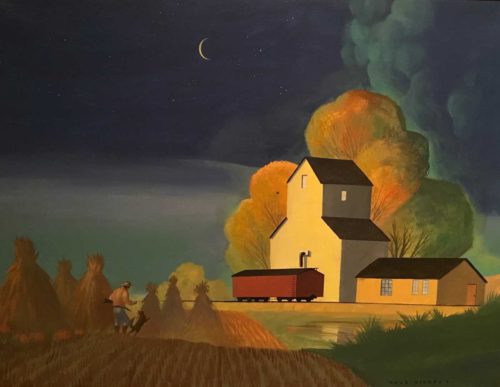KEARNEY — Dale Nichols found his fame in the art world because of Nebraska.
Someone once suggested to the David City artist that “Dale Nichols put Nebraska on the map.”
The long-time illustrator of Encyclopedia Britannica replied, “Dale Nichols did not put Nebraska on the map; Nebraska put Dale Nichols on the map.”
An exhibit of artwork, “Dale Nichols: Nebraska Regionalist,” continues on display through April 2 at the Museum of Nebraska Art at 2401 Central Ave. The exhibit contains selections from the Nichols Collection in the Bone Creek Museum in David City.
“We’ll include the typical ‘red barn’ pieces that he’s known for, but we’ll also have some pieces from when he lived in Guatemala,” said Russ Erpelding, curator and ARTreach Coordinator at the Museum of Nebraska Art. “He’s mostly known for his red barn winter scenes.”
Born in David City in 1904, Nichols left Nebraska to study at Chicago’s Academy of Fine Arts in 1924. He stayed in Chicago for about 15 years where he taught at the University of Illinois and eventually became an illustrator and editor of encyclopedias.
“The show contains four of his paintings from the ‘Four Seasons Collection,’” Erpelding said. “That’s from the collection at Bone Creek.”
Nichols frequently referenced his life in Nebraska in his artwork.
He said of his time growing up in a rural setting: “I feel that an artist paints best what he has been exposed to during his youth. I think my memory paintings of my home state may be my only creations that I sign with full confidence.”
Nichols worked in illustration, painting, lithography and wood carvings.
In 1933, the artist made the decision to devote himself to painting full time. He had been painting less than one year before he produced his best known work, “End of the Hunt,” in 1934. He won an award from the Art Institute of Chicago.
Nichols found a place as one of America’s leading painters. Critics considered him a major figure of the Regionalist movement. The dean of the University of Illinois declared that Nichols “has already achieved a standing in art circles comparable with that of John Steuart Curry, Grant Wood and Thomas Benton.”
In the late 1930s, Nichol’s career began to slip — along with the decline of Regionalism. This personal life also hindered his career. He married five times. Some of his marriages were so brief that the exact date and the full names of his partners were not known.
At one point he purchased half of the town buildings in Tubac, Ariz., to use as an art school. That venture only lasted one year before he ran out of money.
Nichols drifted from Texas to New Orleans to Michigan and finally to Biloxi were he made his home on a small yacht harbored along the Wolf River.
In 1960, the artist moved to Guatemala where he married again and supported himself by making rubbings and drawings of Maya sculpture, selling them to tourists and American archeology museums. During this period, Nichols wrote a book called “Pyramid Text of the Ancient Maya and Magnificent Mystery Tikal,” claiming that he had discovered the secret code of the Mayans, based on the number nine, the birth date of the reader and the position of the sun and the planets.
Nichols rebelled against the idea of modern art because he felt that the natural world should dictate real art, instead of using the rules of the unnatural world.
“In the 1940s, 50s and 60s, his art work showed up everywhere,” Erpelding said. “Decks of card, magazine cover — his work was readily known. He stuck with that theme for years. This is a good example of stylized regionalism and Americana.


